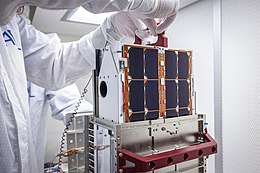Parts of this article (those related to according to ASI website, https://www.asi.it/en/planets-stars-universe/solar-system-and-beyond/liciacube/ mission end was in 2022, so it's probably not operational now) need to be updated. (June 2024) |
 LICIACube at the Applied Physics Laboratory in August 2021 | |
| Mission type | Deep Space CubeSat |
|---|---|
| Operator | Italian Space Agency |
| COSPAR ID | 2021-110C |
| SATCAT no. | T00005 |
| Mission duration | Elapsed: 1 year, 10 months and 7 days |
| Spacecraft properties | |
| Bus | 6U CubeSat |
| Manufacturer | Argotec |
| Launch mass | 14 kg (31 lb) |
| Dimensions | 10 cm × 20 cm × 30 cm (3.9 in × 7.9 in × 11.8 in) |
| Power | Solar array × 2 |
| Start of mission | |
| Launch date | 24 November 2021, 06:21:02 UTC |
| Rocket | Falcon 9 Block 5, B1063.3 |
| Launch site | Vandenberg Space Force Base, SLC-4E |
| Deployed from | DART |
| Deployment date | 11 September 2022, 23:14 UTC |
| Orbital parameters | |
| Regime | Heliocentric orbit |
| Flyby of Didymos system | |
| Closest approach | 26 September 2022 at ~23:17 UTC, or ~19:17 EDT, ~16:17 PDT, 27 September, ~01:17 CET |
| Distance | 56.7 km (35.2 mi) |
| Instruments | |
| |
Light Italian CubeSat for Imaging of Asteroids (LICIACube, IPA: [ˈli.t͡ʃi.əˌkjuːb][1]) is a six-unit CubeSat of the Italian Space Agency (ASI). LICIACube is a part of the Double Asteroid Redirection Test (DART) mission and carries out observational analysis of the Didymos asteroid binary system after DART's impact on Dimorphos. It communicates directly with Earth, sending back images of the ejecta and plume of DART's impact as well as having done asteroidal study during its flyby of the Didymos system from a distance of 56.7 km (35.2 mi), 165 seconds after DART's impact.[2] LICIACube is the first purely Italian autonomous spacecraft in deep space. Data archiving and processing is managed by the Space Science Data Center (SSDC) of the ASI.
- ^ "NASA's DART Mission to Impact Asteroid Monday". Sky & Telescope. 23 September 2022. Retrieved 26 September 2022.
- ^ Cheng, Andy (15 November 2018). "DART Mission Update". ESA. Retrieved 14 January 2019.
© MMXXIII Rich X Search. We shall prevail. All rights reserved. Rich X Search
